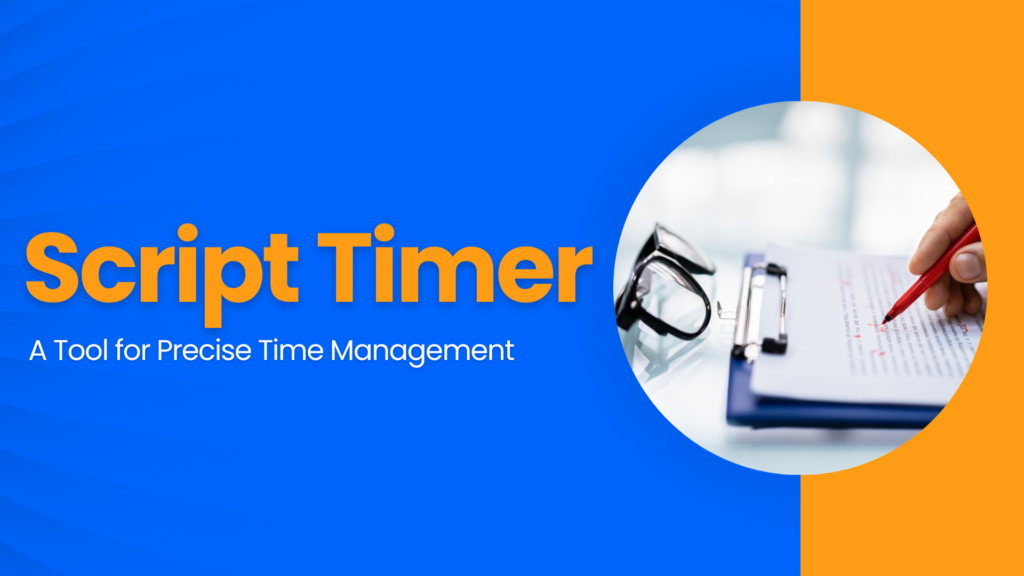In today’s fast-paced digital world, content creators are under constant pressure to craft engaging, bite-sized, and impactful messages. Whether you’re perfecting a podcast script, rehearsing a presentation, or even crafting a compelling story for sales, timing is everything. But how do you accurately gauge the time it takes to read or present your script aloud? Enter the concept of script timing, a magical blend of science, art, and yes, some math. Let’s explore how to calculate the reading time.
1. The Basics of a Script Timer
At its core, a script timer is a tool or formula used to estimate how long it’ll take someone to read or present a script out loud. Generally, the average person speaks at about 125-150 words per minute. So, a simple way to calculate reading time is to divide the total word count by this average.
For instance, if your script is 500 words long:
500 words ÷ 150 words/minute = 3.33 minutes
Seems straightforward, right? But there’s more to this equation than meets the eye.
2. The Role of Pauses and Emphasis
Let’s weave a story. Imagine a seasoned orator, Mr. Stevens, preparing for a grand presentation. Using a basic “script-timer”, he calculated his speech to last 20 minutes. Yet, on the big day, he went over time by 7 minutes! What happened?
Pauses, emphasis, and dramatic effects play pivotal roles in presentation. The same applies to any form of reading out loud. These elements can significantly affect the timing, meaning that your 20-minute calculated speech might end up being 27 minutes in actuality.
3. The Power of Technology
Thankfully, modern problems have modern solutions. Platforms like Listen to your script incorporate nuances like pauses and emphasis, providing a more accurate reading time. So, instead of just relying on manual calculations, using digital tools can offer a more realistic estimate.
To dive deeper into the marvels of this tool, don’t miss out on this insightful read: More Tools for Script Timing.
4. The Importance of Practice and Feedback
Remember our friend Mr. Stevens? After his timing mishap, he began practicing his presentations aloud, with a stopwatch in hand. He then adjusted his pacing based on real-time feedback. The lesson? A timer provides a ballpark figure. But to truly nail your timing, practice and tweak based on feedback.
Want to master this? Take a look at Mastering Public Speaking for tips and tricks.
5. Relating Script Timing to Business Efficiency
Think of a script as a business proposal. In both scenarios, timing, and pacing can make or break the deal. In sales, for instance, storytelling is a potent tool. But what if your sales story drags on? Chances are, your client’s interest will wane. Therefore, understanding and mastering the art of script timing, or having an effective timer at your disposal, is akin to perfecting your sales pitch’s duration.
Still curious about the link between storytelling and sales? This Sales Strategy course on LinkedIn is a must-read.
In Conclusion, Calculating reading time isn’t just about crunching numbers. It’s an intricate dance between word counts, personal reading speeds, pauses, emphases, and real-world practice. As you embrace both the science and art of script timing, remember: that a well-timed script not only respects your audience’s time but also maximizes engagement and impact. Dive into this craft, leverage tools, and practice, and soon, you’ll be a master of the script-timer.
Three Things you can do to keep fast track of your learning:
- Connect on Linkedin as I share valuable lessons weekly.
- Fast track your learning: Get the 6 Steps plus 15 years of Hollywood and Agency experience in one Workshop and masterclass.
- Use the template: 18 Scripts that Sell (also included in every Script-Timer plan.)





